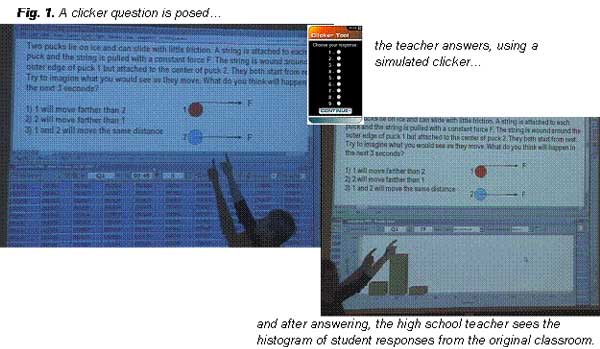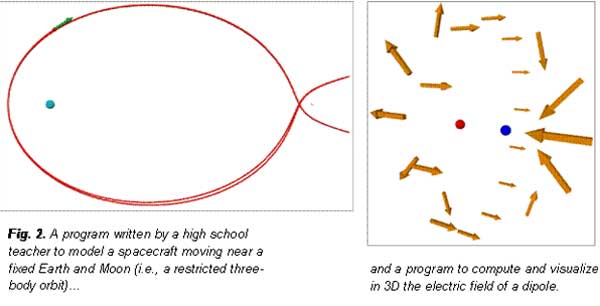21st Century Physics For In-Service High School Physics Teachers
Bruce Sherwood
Introduction
Matter & Interactions [1] is a calculus-based introductory university physics curriculum for engineering and science students that features a contemporary perspective, with emphasis on parsimony (a small number of powerful physics principles rather than a large number of formulas) and on unification (for example, mechanics and thermal physics are treated as one integrated subject rather than two disjoint ones, and electrostatic and circuit phenomena are analyzed in terms of the same fundamental principles rather than completely different methods). The atomic nature of matter is emphasized throughout. Computational modeling is an important component of the course; students write programs to model physical systems and to visualize fields using VPython.
A version of this curriculum consisting of a semester of mechanics and a semester of electricity and magnetism is now offered through the distance education division of NCSU to in-service high school physics teachers in a technologically advanced distance education format, including innovative interactive lectures on DVD. The goal is not to train teachers to teach this university curriculum in high school (although a few teachers are now using it with students who take a second year of physics) but rather to give teachers a contemporary perspective on introductory - level physics, which they did not experience when they were in college. During the distance education course, teachers write reflections on their own learning, which are quite illuminating.
Components of the course
- Textbook (Matter & Interactions)
- Interactive video lectures
- WebAssign computer homework system
- Course web site
- Experiments (may involve video of data acquisition)
- For E&M, a desktop experiment kit
- Computational physics (in VPython)
- Course forum (including reflections)
- Scan/Fax/PDF submissions of reports/tests/etc
- Weekly teleconference (Elluminate)
A novel component is the interactive video lectures, which have the following properties (see Fig. 1). Lectures with interactive clicker questions given by Ruth Chabay were filmed. The video was edited and compressed with one semester of 40 lectures per DVD. The video segments end with a clicker question on the screen. A simulated clicker appears for the distance learner to respond. After the response, the next segment begins with a display of the histogram of the student responses in the original classroom, with discussion. The effect is to provide much of the interactivity of the original lectures.
Many teachers have commented that they found the interactive videos particularly engaging, although a minority said that they would prefer that the videos not stop on a question. In Spring 2010, lectures accompanying the new 3rd edition of the textbook were filmed, and the plan is to edit them to fit into a format in which the halts are optional.


Computational modeling
In the mechanics course, teachers write computer programs using VPython to model physical systems and to see the Newtonian synthesis in action: starting from initial conditions, repetitive updates of momentum and position can predict the future. In the E&M course, teachers write programs to calculate and visualize electric and magnetic fields in 3D (see Fig. 2). One problem is that it is easy to get stuck when writing a program in isolation, so teachers are encouraged to send drafts of programs by email for critique.
Other components of the course
One of the problems in distance education physics courses is the difficulty of including useful activities beyond textbook study and homework. Because the participants are high school physics teachers, in many cases they have access to equipment upon which experiments in the course are based. For an experiment on Young’s modulus which involves measuring the stretch of a long thin wire under load, using equipment most teachers do not have, a video is provided which shows a person taking data, and the teachers must write up an analysis of that data. For E&M, the teachers buy a kit that enables them to do desktop experiments on electrostatics, circuits, and magnetism.
The isolation inherent in a distance education course is partially addressed by the existence of a course forum and by optional weekly teleconferences using Elluminate, a system which includes audio, chat, and a whiteboard upon which all can draw.
Homework is turned in using a computer homework system, WebAssign, for which a large suite of Matter & Interactions problems has been developed by the textbook authors.
Teacher reflections
A recurring assignment for the teachers is to write reflections on what they are learning, and how the new ideas might affect their own teaching. The single most significant element in their reflections has been their reaction to the emphasis on starting analyses from a small number of fundamental principles rather than from a large number of secondary formulas.
Parsimony and unification
Newton introduced the notion of reductionism into physics, that a small number of fundamental principles (parsimony) can explain a wide range of seemingly disparate phenomena (unification). The Momentum Principle (Newton’s second law) plus a universal law of gravitation made it possible to explain the motion of the planets and comets, the tides, and much else.
Reductionism was greatly strengthened in the twentieth century. Quantum mechanics seemed to change everything, yet it turned out that momentum, energy, and angular momentum were still central, giving added weight to parsimony. The discovery that the large number of “fundamental particles” could be explained in terms of a small number of quarks and leptons was another powerful demonstration of parsimony. The identification of just four fundamental interactions (gravitational, electromagnetic, strong, and weak), which then collapsed to just two (gravitational and the Standard Model), was the result of a drive for unification.
However, the twentieth century perspective on the power of parsimony and unification, which is at the core of contemporary physics, was scarcely represented in the physics courses these high school teachers took in college. As a result, they found a reductionist approach to introductory physics an eye-opener and often commented in their written reflections on how this approach had made a big impact on their view of physics, and that it was triggering significant changes in their own teaching.
Reference
[1] Ruth Chabay and Bruce Sherwood, Matter & Interactions (3rd edition, 2010), John Wiley & Sons, Hoboken NJ. See the webpage http://matterandinteractions.org.
Bruce Sherwood is Professor Emeritus from North Carolina State University and now lives in Santa Fe, NM.
Disclaimer - The articles and opinion pieces found in this issue of the APS Forum on Education Newsletter are not peer refereed and represent solely the views of the authors and not necessarily the views of APS.
